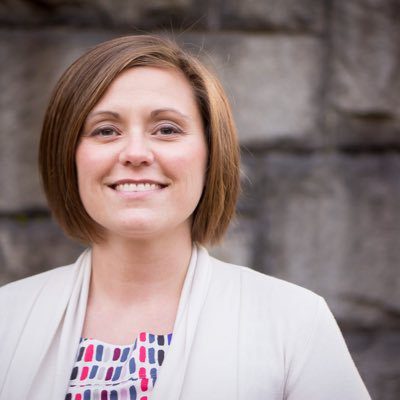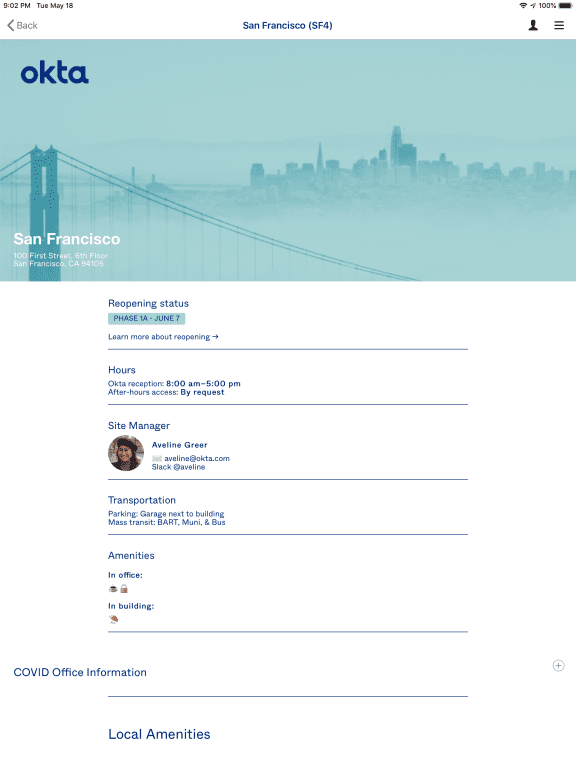Okta’s path to navigating the future of work
As the head of remote trend takes off, user authentication company Okta is defining its own path by appointing a ‘head of dynamic work’. Just nine months into the role, Samantha Fisher reveals the key differences – and why they matter.
Why You Should Care
Dynamic work profiles map flexibility levels in each role, team and department.
Companies can understand office presence, geographical dispersion and mobility.
This frames employee-manager dialogue around flexibility and career progression.
Overhauling benefits to be more lifestyle specific, creating employee profiles based on flexibility options and launching a new virtual office app has been all in a day’s work for Samantha Fisher, head of dynamic work at identity security platform Okta.

Samantha Fisher, head of dynamic work, Okta
It’s proof that the intentional wording of her job title is justified. It’s been carefully constructed to reflect that while Okta expects around 85% of its 4,200-strong workforce to end up fully remote within the next two years – up from 30% pre-pandemic – the time is right to create a consistent culture and experience across work location and geographies.
Fisher says: “From the remote perspective, those teammates don’t always feel connected to the organization, and the organization doesn’t always think about the ways in which the employee needs to be connected.
“For most organizations, prior to the pandemic that was less than 20% of their workforce. In a large company they can become ‘second-class citizens’.”
She continues: “When you think about a distributed workforce, they are generally not organized around employee experience.
“Yes, you can work wherever you want. But things like benefits and compensation are still decided at a central location that primarily is not where the distribution is.
“They’re not always taking into consideration the cultures or the geographies, the life experiences of where the demographic is, relative to how that work-life balance is going to happen. Because they’re still primarily a centralized organization, with a centralized perspective.”
Why dynamic is different
Dynamic is different, Fisher clarifies, exactly because it considers all these things.
Okta – used by more than 13,050 global brands including Just Eat and made.com – has reviewed compensation in light of remote working, with co-founder and chief executive Todd McKinnon backtracking on the decision to cut salaries for workers relocating to benefit from remote work.
“We’re exporting top market salaries all over the place,” McKinnon told the Wall Street Journal.
Sick leave and unlimited personal time-off policies are also universal across locations and geographies, while the company is “working towards” universal parental leave, Fisher says.
She and her team have also been assessing how different employees value certain benefits as Okta continues to grow its headcount outside of the US.
“We’re working with a lot of our carrier partners on how we also provide [benefits available in the US] in non-US locations,” Fisher says.
“[That means] Having a place where employees log in, see all their options, and make the right alignment based on where they are in their life and what’s important to them.”
People joining Okta straight from university may be more interested in learning opportunities or fitness benefits and have different priorities to people with children, or those living with elderly parents, which may be more common in APAC than in the US, she elaborates.
“So that is the entire assessment we have been going through, particularly with our acquisition of Auth0. What are those different facets we have to consider? How much of it is ‘paternalistic’, versus how much of it is self opt-in? Then what is an easy way we can package that?”
The beauty in it, she adds, is benefits would be transferable as employees move across markets.
Introducing dynamic work profiles
Helping employees understand mobility across roles is also a big spotlight for Fisher, with the creation of ‘dynamic work profiles’ – crediting the Workday platform for helping Okta develop and roll these out.
Dynamic work profiles essentially map out what level of flexibility each role in each team and department allows, and if someone is looking for more flexibility, where in the organization they could move based on what dynamic work profile fits.
This involved looking at all of the company’s roles, and functions and analyzing the requirement for each of those to be tied to an office, geographically ‘co-located’ or not at all, under the overarching lens of who their customer is.
The result so far is three different types of roles.
A ‘dynamic workplace’ role describes primarily people who are in-office support, such as Okta’s workplace and business technology teams, which is focused on helping employees be productive by making quality spaces, amenities and services accessible to the wider organization.
A small percentage of the organization, these roles are generally tied to a specific office. Flexibility can be built within that framework via discussion with a manager.
A ‘partial dynamic’ role isn’t connected to an office, but is bound to certain time zones as these center on sales and customer teams that serve a specific geography.
Finally, ‘fully dynamic’ roles – like Fisher’s – are cross-functional and support the whole organization, or a broad reach of clients.
Currently, around 7% of Okta employees are in dynamic workplace roles, 48% are partial dynamic, and 45% are fully dynamic, considered remote.
“These designations help us understand not only office presence, but geographical dispersion and the mobility between them. We look at who you’re supporting. Then combined with your job function, we say, ‘here’s the work profile you fall into’,” Fisher comments.
“So as a fully dynamic employee, I can live anywhere domestically, because I support my customers all over the country. If I’m a partially dynamic employee, I need to stay in the time zone or the region where the bulk of my customers I’m serving reside.”
Setting such expectations can frame employee and manager conversations around flexibility and mobility, and helps team members consider progression opportunities.
“This just enables managers and leaders to better understand what optionality exists for those employees,” Fisher adds.
Creating a digital concierge
Okta’s ‘digital concierge’ app, Atmosphere, has also been integral to the dynamic work experience.
Fisher likens it to a virtual office on your mobile, personalized to employees’ job location, team and function.
It also enables people to book conference rooms, locate amenities, book smart lockers, receive office announcements, report workplace issues; and it gives real-time updates on aspects such as events, site information and co-worker schedules.

Atmosphere certainly sounds a cut above the traditional company intranet, but Fisher is careful not to call time on such a legacy corporate tool, describing the app as a “digital companion to dynamic work”.
“There’s definitely old-school intranet, there’s also the new school, which are more like social platforms for organizations.
“It’s not an ‘either or’ – it’s an augmenter. We will have something internal that people can use on their desktop, and we will have digital signage in the actual physical workplace.
“Then you have your hand-held device to complete the trifecta of all the different places that people need to go to get information,” Fisher rationalizes.
The path to building a ‘world class workplace’
Fisher has certainly hit the ground running to help Okta navigate its dynamic work positioning, which is what drew her to the role in the first place.
“The incredible part of this role was not just the fact that Okta as an organization was putting a stake in the ground, in a volatile period when many companies weren’t.
“I appreciated the fact that Okta said, ‘This is the way we’re going to do it, we’re going to measure it – we think this is the right thing’,” Fisher asserts.
“The other part of it was being able to think about our employees as customers, and what their journey is.
“Then thinking strategically around what does that mean for the entire organization – so really having an impact on an employee’s experience.
“We get to say, ‘here’s what employees, as customers, are telling us’. So this is what we need to think about from an equity and inclusivity perspective, and in wanting to retain our employees, and attract and hire the best talent.”
Regardless of where an employee is or how they work, Fisher believes they should feel connected to, empowered by and invested in by an organization.
It’s not an easy thing to achieve, and there will be “pivots along the way”, Fisher acknowledges – but this is what it will take to build the “world-class workplace” Okta is striving for.
Sign up to the UNLEASH Newsletter
Get the Editor’s picks of the week delivered straight to your inbox!

Freelance Journalist
Business writer covering the future of work, sustainability, innovation, technology, startups, marketing and more.
